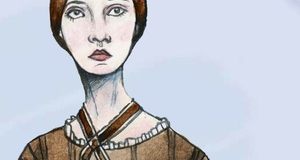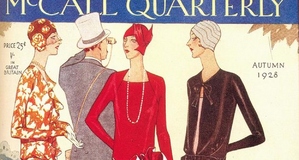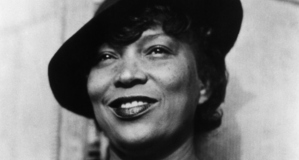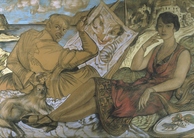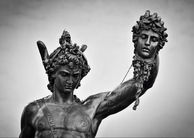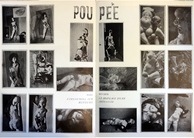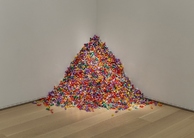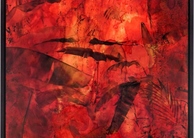The Eternal Search for Truth: A Comparative Analysis of Marie Denise Viller's A Young Woman Drawing and George De La Tour's The Penitent Magdalen
By
2012, Vol. 4 No. 07 | pg. 2/2 | « Unlike Villers, who employs composition in such a way so as to express hopelessness and emptiness, La Tour utilizes composition to express the importance of feeling and passion. Like Villers, La Tour makes use of negative space to direct the viewer’s eye. However, rather than focusing the viewer’s attention first on the subject itself as does Villers (in specific the subject’s defeated posture), he focuses the viewer’s attention upon the group of objects on the right side of the composition which symbolize Mary’s inner emotions. The artist achieves this effect by presenting the greatest contrast of light and dark between the mysterious black abyss, the brass mirror, and the blindingly bright flame within the painting. The skull resting on Mary’s lap is placed near the mirror and the flame in order to force the viewer to focus on this object immediately after gazing at the mirror and the flame, and to associate these three objects as a group. According to the painting’s accompanying wall plaque at the Metropolitan Museum of Art, the mirror serves as a symbol of vanity, the candle symbolizes spiritual enlightenment, and the mirror symbolizes mortality (Wall Text). La Tour focuses the viewer’s attention on this part of the composition first because he wants his audience to understand that Mary is experiencing extreme emotional turbulence in regards to whether or not she should renounce her indulgent lifestyle to follow Christ. La Tour utilizes these objects to suggest to the viewer that yes, Mary is grappling with significant life questions, and yes, she may be regretful of her previously sinful life, but at least she is allowing herself to feel and to experience emotion, in contrast with the woman in A Young Woman Drawing, who has succumbed to numbness. Mary has put herself out there to experience life—and although confusion, guilt, and fear may follow—only through her experiences, her feelings regarding those experiences, and her ultimate conclusions from those experiences can Mary ultimately determine which life path suits her. Because the wall which is located behind Mary is lighter than the wall located behind the mirror and objects, Mary stands out less in comparison to the bright symbolic objects and the dark black background, and therefore the viewer naturally looks at this part of the painting secondly. La Tour purposely places just the tip of Mary’s turned profile against the dark black background (against which the other objects are set) because he again wants the viewer to notice Mary’s face immediately after gazing at the objects; he wants to communicate the idea that the objects (and their symbolic meanings) are physical manifestations of Mary’s emotional turmoil and that they serve as the reason for why Mary’s face is turned away from the viewer. Mary’s face is turned away from the viewer not only to suggest that she is too ashamed of her past lifestyle to confront the viewer directly, but also to suggest once again that the viewer’s thoughts and feelings regarding Mary’s life direction are entirely unnecessary to her because she has made the decision to take charge of her life on her own. Villers, in contrast, paints the woman’s face turned toward the viewer to directly involve the viewer in the woman’s feelings and to suggest that the woman’s life is completely dependent upon the perceptions and feelings of others, precluding her from attaining the fulfillment in life that the independent Mary can attain.After noting Mary’s face, the viewer then gazes at the remainder of Mary’s body. La Tour has purposely painted Mary sitting upright because he wants to suggest that Mary almost possesses a certain sense of pride in having experienced life, in having realized that she behaved in a manner which she considered to be wrong, and in having taken action to alter the course of her life direction without the influence or aid of anyone else. Villers, in contrast, positions the woman in a hunched position, as mentioned earlier, to suggest that the woman feels absolutely hopeless about being able to turn her life around. Whereas La Tour directs the viewer’s eye to the subject secondly, Villers directs the viewer’s eye to the woman and her hunched posture firstly because she wants the viewer to understand that defeat completely consumes the woman. In A Young Woman Drawing, both the color scheme and the lighting serve to further reinforce the grasp that society has upon the woman. Villers employs a pastel color scheme within the painting, and as a result, no tension exists between the colors. The soft white of the woman’s dress, for example, is complemented by the salmon pink of the drape upon the chair which effortlessly melds into the light brown wall and floor. Similarly, there is no dramatic contrast within the lighting that escapes from the window and gently illuminates the woman. The softness of both the lighting and the color scheme creates a sense of harmony, reason, and order within the painting, which, as mentioned earlier, were prominent societal values of the time to which the woman is expected to abide. Society will spurn the woman if she tries to defy this order in an attempt to discover her passions. The lack of tension between the lighting and color not only reminds the viewer that societal values dictate the woman’s life, but they also serve to reflect the woman’s complete lack of emotional passion and feeling due to her capitulation to those values. In contrast, Penitent Magdalen features intense lighting and colors to allude to the fact that no external factors have control over Mary; her inner emotions are wild and utterly untamable. Great tension exists between the colors. The bright white of Mary’s blouse contrasts with the deep blood red of her skirt. The pitch black background (in the left side of the composition) contrasts with the bright brass mirror and the even brighter candle flame. Significant contrast also exists within the lighting. Mary and the other figures within the painting emerge out of a dark background, illuminated by a source outside of the picture frame, as if in a spotlight (tenebrism). This notion of the spotlight effect is supported by the idea that the light in the painting is not evenly distributed. The side of Mary’s skirt, for example, and left side of Mary’s visible arm are completely in shadow because the “spotlight” does not reach these areas. Conversely, Mary’s upper torso, the thin frontal strip of her skirt, and the objects on the table are all brightly illuminated because the “spotlight” reaches these areas. By creating significant contrast within lighting and color, La Tour creates energy and reflects the turbulence of Mary’s inner emotions. Unlike the woman in A Young Woman Drawing, Mary feels passionately about her life direction, which is good because only through deep feeling and self-reflection can an individual determine which life direction will ultimately provide the most personal fulfillment. In many ways, A Young Woman Drawing is similar to the painting Oath of the Horatii by Jacques-Louis David. Both are neoclassical paintings. A sense of harmony and balance dominates each of the paintings because these were the values that society upheld at the time, drawing on the reason and logic that persisted in the times of antiquity. Both contain backgrounds which help to make the space of the composition understandable, relying on clean, crisp, logical architectural elements (influenced by the architecture of antiquity) to achieve this effect. In the Oath of Horatii, this is achieved through the use of Roman arches around which the subjects are evenly separated, further contributing to the stability of the painting. In A Young Woman Drawing, this is achieved through the simplicity of the room in which she dwells and the use of the horizontal and vertical lines (along the wall and window) to create axes around which the composition is centered. Both paintings touch on the idea that society praised and promoted the value of self-sacrifice, however, Oath of the Horatii depicts the honor of self-sacrifice through the strength and power of the Horatii brothers while A Young Woman Drawing rejects the idea of self-sacrifice without self-exploration beforehand through the emptiness of the woman’s facial expression. Additionally, an artificial sense of calmness characterizes the facial expressions of the subjects of both paintings. For example, in Oath of Horatti, only the women’s slumped body positions indicates that they are distressed that their husbands are leaving for war; their faces are oddly serene, contradicting the true inner turmoil that the women must be feeling. Similarly, the woman in Villers’ painting does, at first glance, appear to be rather calm (the soft color scheme and lighting contribute to the notion that the woman is at ease). It is only upon deeper analysis and examination that the viewer understands that the woman is tortured internally. Because, during the time of the Enlightenment, emotion and subjectivity were rejected, it makes sense that neither paintings would reflect the actual emotional torture that the women felt; it makes sense that, at first glance, logic and reason appear to dominate the composition. Penitent Magdalen is in many ways similar to Carravagio’s The Calling of St. Matthew. The paintings are Baroque paintings, although Carravagio’s work is Italian Baroque while La Tour’s work is French Baroque. Both pieces utilize negative space to emphasize the importance of the subjects. Both paintings make use of tenebrism to highlight the important features of the scene and to make the piece overall more dramatic in order to engage the viewer. Engaging the viewer would have been particularly important because, during the Baroque period, Protestantism was gaining popularity and people were beginning to doubt the power of Catholicism and the papacy. The papacy needed to retain its followers, and so both works express deeply Catholic messages—the idea of shedding worldly possessions to follow the light of Christ—in a way that would appeal and relate to the viewer. The intense color scheme of both works help to heighten the drama and appeal. Additionally, both paintings place highly religious subjects in commonplace settings, causing the figures to be more relatable to the viewers and suggesting that even the most religious figures struggled to determine the life path that would provide them with the most fulfillment. Through the comparison of Villers’ and La Tour’s artistic techniques—mainly rhythm, composition, and color and light—both artists communicate the importance of self-discovery in determining satisfaction with life. As suggested by the techniques employed in A Young Woman Drawing, without self-discovery, individuals can never develop a personal set of values to which they can commit their lives. They must live an inauthentic life consistent with the morals of society, which ultimately leads to numbness and loss of hope. As suggested by the techniques employed in Penitent Magdalen, experiencing life on a firsthand basis—regardless of societal opinion—is the only way to truly develop a set of personal morals and values to which one can live by. Although it may be more difficult to defy the norm and experience life in a manner which one sees fit—although great emotional turbulence might accompany this mentality—the only way to truly find happiness in life is through feeling and experience. ReferencesDavid, J. (1874). The Oath of the Horatii [painting]. Paris, France: The Louvre Museum. Villiers, M. (1801). A Young Woman Drawing [painting]. NYC, NY: The Metropolitan Museum of Art. Caravaggio, M. (1599-1600). The Calling of Saint Matthew [painting]. San Luigi dei Francesi, Rome: Contrarelli Chapel. La Tour, G. The Penitent Magdalen [painting]. NYC, NY. The Metropolitan Museum of Art. Retrieved from Oxford Art Online Database. Wall text. The Penitent Magdalen [painting]. Gallery 620. NYC, NY: The Metropolitan Museum of Art. Suggested Reading from Inquiries Journal
Inquiries Journal provides undergraduate and graduate students around the world a platform for the wide dissemination of academic work over a range of core disciplines. Representing the work of students from hundreds of institutions around the globe, Inquiries Journal's large database of academic articles is completely free. Learn more | Blog | Submit Latest in Visual Arts |







